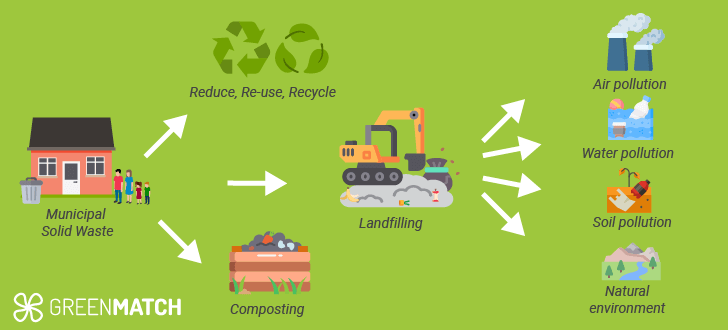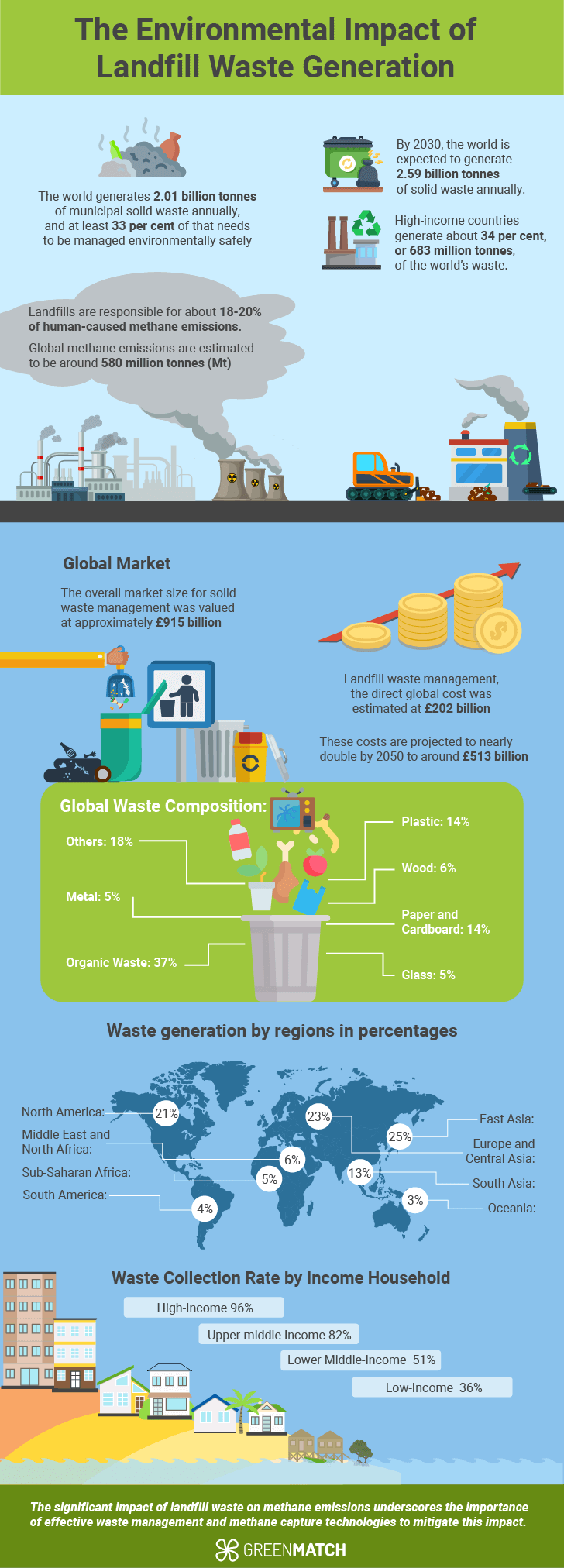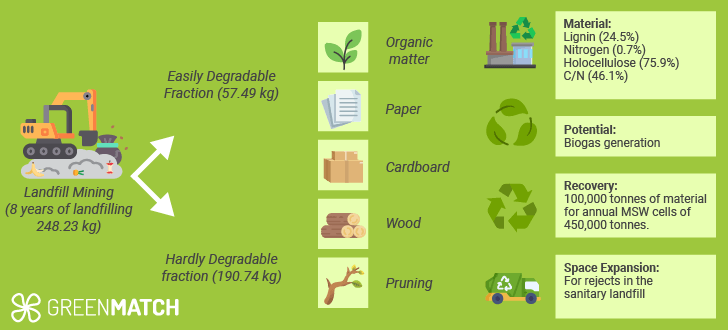- GreenMatch
- Blog
- Why Are Landfills Bad for the Environment? Stats, Trends, and Fact
Why Are Landfills a Threat to the Environment?

Landfills are a significant source of methane, a potent greenhouse gas 84 times more effective at trapping atmospheric heat than carbon dioxide over 20 years. Methane emissions from landfills contribute significantly to global warming and climate change.
It is notorious for its adverse environmental effects, including greenhouse gas emissions, soil and water contamination, and natural habitat destruction.

Heavy metals and other pollutants in landfill waste can lead to soil contamination, reducing its fertility and altering its chemical composition. This not only affects plant growth but also impacts the broader ecosystem services that healthy soil supports.
The UK faces a potential landfill capacity crisis, with existing sites nearing full capacity and new sites difficult to establish due to public opposition and environmental concerns. The Environmental Protection Agency (EPA) states that landfills are the third-largest source of methane emissions in the United States, contributing a whopping 14.8% in 2021.
The journey from realising the gravity of landfill effects to finding sustainable solutions introduces many considerations, including methane emissions, landfill gas, and the overarching environmental impact. This article explores these critical topics, offering insights into why landfills harm the environment.
What Do We Mean by Landfills Exactly?
Landfills, in the simplest terms, refer to disposing of large amounts of rubbish by burying it or where this disposal occurs. This method of waste disposal is one of the oldest and most common globally. The term 'landfill' often brings to mind municipal or sanitary landfills, scientifically designed sites where waste is systematically buried.
These facilities are constructed to minimise the environmental impact by controlling emissions of gases, liquids, and solid materials.

Landfills pose significant environmental risks. They are sources of methane, a potent greenhouse gas, and can lead to groundwater contamination through leachate. Composing waste in landfills contributes to air pollution and can affect local biodiversity.
| Region | Total Waste Generated (tonnes/year) | Percentage Sent to Landfill |
|---|---|---|
| Asia | 1 billion | 49% |
| North America | 289 million | 52% |
| Europe | 221 million | 23% |
| Africa | 125 million | 64% |
| South America | 160 million | 57% |
Properly managed plays a critical role in waste management by ensuring that the gases produced during the decomposition of waste are either flared or recovered for energy generation. In some countries, extensive landfill gas recovery contributes to cleaner energy production by generating electricity.
Types of Landfills
- Municipal Landfills: Typically referred to by the shorthand 'landfill', these are meant for everyday waste disposal from households and businesses.
- Sanitary Landfills: These are designed as biological reactors where microbes degrade organic waste into more straightforward, less toxic compounds over time.
- Solar Landfills: Innovative use of closed landfills, repurposed as solar farms, harnessing solar energy on previously used land.
Environmental Impact of Landfills
Landfills contribute to climate change through methane emissions. As organic waste decomposes anaerobically in landfills, it releases methane into the atmosphere, exacerbating global warming.
Additionally, landfills produce leachate, a toxic liquid that can contaminate groundwater and surface water, posing risks to ecosystems and human health. In the UK, landfills contribute 27% of total methane emissions, highlighting waste management's significant role in national greenhouse gas profiles.
Besides methane, landfills emit carbon dioxide, water vapour, trace amounts of oxygen, nitrogen, hydrogen, and non-methane organic compounds. These emissions contribute to climate change and smog, exacerbating air quality issues.
In regions with stringent waste management regulations, such as the European Union and parts of the United States, the environmental impact is mitigated through technologies like methane capture and strict regulatory frameworks. However, in many developing countries, open dumps are common, and the ecological management of landfills is less controlled, leading to more severe environmental degradation.

This illustrates the distribution of methane emissions from landfills across key global regions, highlighting the significant contribution to global greenhouse gas emissions.
What is so bad about Landfill for the environment?
- Methane and Other Greenhouse Gas Emissions: As organic waste decomposes anaerobically in landfills, it releases methane into the atmosphere, exacerbating global warming.
- Impact on Water and Soil: Leachate, a toxic liquid that forms when waste breaks down in the landfill and water filters through that waste, poses a severe threat to water quality. It can leak and contaminate nearby water sources, leading to eutrophication and creating "dead zones" where no life can exist. The mix of toxic substances and decaying organic material in landfills can significantly distort soil fertility and activity, negatively affecting plant life.
- Biodiversity and Habitat: The creation of landfills leads to significant habitat loss. The average landfill size in the United States is 600 acres, contributing to substantial ecological disruption. The presence of landfills can destroy wildlife habitats and attract large amounts of rodents, impacting local businesses and communities. Additionally, coastal landfills are at risk of flooding and erosion, threatening marine life.
- Toxic Chemicals: PFAS, known as "forever chemicals", is found in landfill leachate. It persists in the environment and has been detected at levels up to 260 times higher than England's current guidance for safe drinking water levels.

What is the impact of Landfill?
Total impact per year
Globally, landfills emit approximately 1.6 billion tonnes of carbon dioxide equivalent greenhouse gases annually. This accounts for about 5% of global emissions, driven primarily by waste disposal in open dumps and landfills without gas collection systems.
Impact per day
Daily, the world generates 2.01 billion tonnes of municipal solid waste annually, with a significant portion ending up in landfills. This equates to approximately 5.5 million tonnes of waste being landfilled daily, contributing to the continuous release of methane and leachate production.
Impact per usage
For every tonne of waste in a landfill, there is a missed opportunity for recycling or composting, which could significantly reduce environmental impacts. For instance, recycling textiles instead of landfilling them could prevent the emission of 3.6 tonnes of CO2 per tonne of textile waste.
Top Largest Economies Contributing to Landfill
Landfills remain a significant environmental challenge, exacerbated by the waste management practices of some of the world's largest economies. This section delves into the countries that contribute notably to landfill volumes, highlighting their current practices and the urgent need for more sustainable waste management solutions.
- United States: A Leading Contributor
The United States is the largest global waste producer, with each citizen generating approximately 811 kg annually. About half of this waste is in landfills, contributing to significant methane emissions and other environmental hazards.
- China: Industrial Growth Leading to Increased Waste
China's industrialisation and urbanisation have led to increased waste production. Although recycling initiatives are in place, the scale of waste generation overwhelms current management capacities, resulting in significant landfill use.
- European Union: High Waste Production with Robust Management
In the European Union, stringent waste management regulations help mitigate the impact of high waste volumes. For instance, the EU's Landfill Directive aims to reduce landfill use by promoting recycling and incineration. Despite these efforts, substantial amounts of waste still find their way into landfills, with variations in compliance among member states.
- India: Urban Expansion and Landfill Challenges
Due to urban expansion and limited recycling infrastructure, India faces critical waste management challenges. High population density and rapid urbanisation exacerbate the situation, leading to the proliferation of landfills and increased environmental risks.
| Country | Waste per Capita (kg/year) | Percentage of Waste Landfilled |
|---|---|---|
| United States | 811 | 50% |
| European Union | Varies by country | Varies by country |
| China | 520 | 60% |
| India | 500 | 50% |
| Brazil | 380 | 59.5% |
Insights and Global Impact
These countries, representing some of the world's largest economies, play a significant role in global landfill contributions. Their waste management practices and policies significantly impact global environmental health.
However, several countries are leading the way in reducing landfill use through innovative waste management strategies:
- Germany and Sweden have implemented aggressive recycling and waste-to-energy programs that minimise landfill use.
- South Korea has dramatically reduced food waste through composting initiatives.
By adopting more sustainable waste management practices, we can mitigate the environmental, health, and economic impacts.
Statistics, Facts, and Figures About Landfills
- Globally, we generate 2.01 billion tonnes of municipal solid waste annually, with projections indicating a rise to 3.40 billion tonnes by 2050.
- Currently, at least 33% of this waste needs to be managed environmentally safely.
- Despite representing only 16% of the world’s population, high-income countries generate about 34% of the world's waste.
- Landfills are the US's third-largest source of human-related methane emissions, contributing to about 15% of these emissions.
- Methane, a potent greenhouse gas, exacerbates global warming.
- Over 267.8 million tons of waste are generated annually in the US, with a significant portion ending up in landfills.
- The UK faces a potential landfill capacity crisis, with existing sites nearing full capacity and new sites difficult to establish due to public opposition and environmental concerns.
- The global waste recycling market is expected to grow, reaching a value of approximately £62 billion by 2027.
- Asia, Europe, and North America lead in waste generation, with Asia topping the list at 468 million tonnes annually.
- Despite advancements in waste management, the global recycling market is valued at £61 billion.
- About 50% of the 230 million tonnes of yearly waste in the United States enters over 2,000 active landfills.
- In high-income countries, only 2% of waste is in landfills; this figure skyrockets to approximately 93 in low-income countries.
The table below provides a snapshot of waste generation and landfill use across various regions:

Landfill Impact Statistics
| Country | Annual Waste Generation (tons) | Percentage to Landfills |
|---|---|---|
| USA | 267.8 million | 52% |
| UK | 222 million | 44% |
| Canada | 25 million | 30% |
How Toxic are Landfills for the Environment?
Living near landfills has been associated with a 12% increased risk of congenital malformations in children, highlighting the severe health risks these sites can pose to nearby communities.
Moreover, the odours from landfills, caused by various chemicals released as gases, can be detected at deficient concentrations. This chemical, a type of PFAS, is linked to several severe health issues in humans, including kidney and testicular cancers, hypertension, thyroid disease, and a reduced response to vaccines.
In addition, these facilities produce emissions equivalent to significant lengths of UK motorways. For instance, oxides of nitrogen from an EfW plant match those produced by a 7km stretch of motorway hourly. Similarly, particulate matter emissions are comparable to a 5km length of UK motorway.
Comparative Toxic Emissions from Landfills and EfW Plants
| Emission Type | Equivalent Source |
|---|---|
| Oxides of Nitrogen | 7km of UK motorway (hourly) |
| Particulate Matter | 5km of UK motorway (hourly) |
| Cadmium | One-twentieth of a medium-sized coal-fired station |
| Dioxins and Furans | Accidental fires in a town of 200,000 population |
How Long Does It Take for Landfill Products to Biodegrade?
Understanding the biodegradation timeline of products in landfills is crucial for assessing environmental impacts and improving waste management strategies. Here, we explore the decomposition rates of everyday waste items, providing a clearer picture of landfill longevity and its impact.

Biodegradation Timelines for Common Materials
The rate at which products biodegrade in landfills varies significantly based on the material composition and landfill conditions. Here’s a quick look at the decomposition rates for commonly discarded items:
- Organic Waste (Food Scraps, Garden Waste): Decomposes within weeks to months but can generate methane, a potent greenhouse gas.
- Paper: Breaks down from 2 to 6 weeks under optimal conditions but can take longer if compacted in a landfill, lacking oxygen.
- Cardboard: Typically degrades within two months but may take longer depending on the landfill's moisture and oxygen levels.
- Plastics: Conventional plastics can decompose anywhere from 20 to 500 years. Biodegradable plastics may reduce this time but require specific conditions to break down effectively.
- Cans and Metals: These materials do not biodegrade. Glass can last indefinitely, and metals may rust but do not break down into harmless substances. Steel cans and aluminium products are some of the most enduring materials, breaking down from 50 to 500 years.
- Textiles: Natural fibres like cotton and wool decompose relatively quickly, taking about six months and one year. In contrast, synthetic fibres like nylon and polyester are far more persistent, taking 30 to 40 years and over 500 years, respectively.
- Wood and Lumber: Wood from trees, such as stumps and branches, can decompose 50 to 100 years if left whole. Smaller or more processed pieces may degrade at different rates.
- Plastics and Synthetics: Plastics and styrofoam represent significant challenges, with decomposition times exceeding 500 years. This includes everyday items like plastic bags and packaging materials.
- Glass: One of the most durable materials, glass can take 1 to 2 million years to naturally break down in a landfill setting.
Can it be Managed Sustainably?
The world generates over 2 billion tonnes of waste each year. Of this, 37% end up in landfills. These sites produce significant methane emissions, contributing to climate change.
Recent advancements have introduced more sustainable practices in landfill management. These include enhanced methane capture technologies, using biodegradable liners to minimise leachate production, and integrating solar panel covers to generate renewable energy while capping waste.
Countries around the world are adopting these innovative practices. For example, the Netherlands has pioneered Sustainable Landfill Management (SLM), using natural processes to stabilise waste materials, significantly reducing the need for long-term care and environmental monitoring.
Also, The European Union has made significant strides in waste management, with landfill rates decreasing from 23% to 16% between 2010 and 2020. This reduction is part of a broader shift towards a circular economy, prioritising waste prevention, recycling, and recovery over disposal.
| Country | Methane Emissions (Million tonnes) | Sustainable Practices Adopted |
|---|---|---|
| USA | 1.2 | Methane Capture, Recycling |
| Netherlands | 0.3 | Sustainable Landfill Management (SLM) |
| India | 0.9 | Methane Capture, Community Engagement |
| UK | 0.4 | Recycling, Waste Reduction Programs |
Looking ahead, the focus is shifting towards reducing landfill use through increased recycling and waste reduction strategies.
Environmental Impact Compared to Everyday Things
Landfills are not just eyesores; they are significant sources of CO2 emissions. When organic waste decomposes in landfills, it releases methane, a potent greenhouse gas. Methane has a global warming potential 28 times greater than CO2 over 100 years.
This means landfills could generate about 1,300 million metric tons of CO2 annually worldwide. This is equivalent to the emissions from over 24 million gasoline-powered vehicles or the annual energy use of more than 13.1 million homes. This enormous figure often goes unnoticed, overshadowed by more visible sources of pollution.
But how do these emissions stack up against everyday items and activities we often overlook?
To put landfill emissions into perspective, let's compare them with everyday items and activities:
- Driving a Car: The average petrol car emits about 2.31 kg of CO2 per litre of fuel burned. Considering the average car fuel consumption is about 7.6 litres per 100 kilometres, a 10 km trip releases approximately 1.75 kg of CO2.
- Electricity Consumption: The average household electricity consumption in the UK emits about 0.233 kg of CO2 per kWh. Watching TV for 3 hours a day annually emits roughly 255 kilograms of CO2.
- Flying: A single flight from London to New York emits approximately 986 kg of CO2 per passenger.
In the UK alone, landfills emitted approximately 22 million tonnes of CO2 equivalent. When comparing these figures to landfill emissions, the scale becomes apparent. Landfills contribute more to global CO2 levels than most daily activities combined. This stark contrast highlights the urgent need for waste management reform and improved recycling efforts.
What Are Alternatives to Landfill?
Landfills dominate waste management, but viable alternatives exist. These options reduce environmental impact and promote sustainability.
Here are some of the most effective alternatives:
- Recycling
- Why It's Better: Recycling converts waste into reusable materials. It reduces landfill waste, conserves resources, and lowers greenhouse gas emissions.
- Example: Germany recycles 67% of its waste, leading the world in efficient waste management.
- Composting
- Why It's Better: Composting organic waste produces nutrient-rich soil. It decreases landfill input and cuts methane emissions.
- Example: San Francisco composts 80% of its organic waste, supporting local agriculture.
- Incineration with Energy Recovery
- Why It's Better: Incineration reduces waste volume by 90% and generates energy. Modern plants control emissions effectively.
- Example: Sweden incinerates waste to produce heat and electricity for thousands of homes.
- Anaerobic Digestion
- Why It's Better: Anaerobic digestion converts organic waste into biogas and compost. This process produces renewable energy and reduces landfill waste.
- Example: The UK utilises anaerobic digestion to handle 3.5 million tonnes of organic waste annually.
- Waste-to-Energy (WtE)
- Why It's Better: WtE plants burn waste to generate electricity. This method reduces landfill dependence and produces renewable energy. However, they use advanced technology to capture the energy produced during waste combustion efficiently.
- Example: Denmark's WtE plants supply power to 500,000 homes, cutting landfill use drastically.
| Alternative | Waste Processed (Million Tonnes) | Greenhouse Gas Emission Reduction (%) | Energy Produced (MWh/year) | Investment in Technology (GBP Billion) |
|---|---|---|---|---|
| Recycling | 500 | 60 | N/A | 12 |
| Composting | 300 | 50 | N/A | 5 |
| Incineration with Energy Recovery | 200 | 70 | 15,000,000 | 10 |
| Anaerobic Digestion | 150 | 65 | 10,000,000 | 7 |
| Waste-to-Energy (WtE) | 250 | 75 | 20,000,000 | 15 |
Is Landfill Better Than Its Alternatives?
Landfills are similar to their alternatives when considering environmental impact. Alternatives like incineration, composting, and recycling offer significant advantages:
- Reduced greenhouse gas emissions: Alternatives like incineration and composting emit fewer greenhouse gases than landfills, producing methane, a potent greenhouse gas.
- Energy production: Methods like incineration and WtE generate energy from waste, something landfills cannot achieve.
- Resource recovery: Recycling and MRFs allow for the recovery and reuse of materials, reducing the need to extract new raw materials and conserving natural resources.
Given these points, alternatives to landfills mitigate environmental damage and provide additional benefits like energy production and resource conservation, making them superior options for waste management.
Frequently Asked Questions about Landfill
Landfills contribute significantly to environmental degradation. They release methane, a potent greenhouse gas, and leachate, a toxic liquid contaminating water sources. These emissions contribute to air and water pollution, soil degradation, and adverse health effects on nearby communities.
- Methane Emissions: Landfills release methane, significantly contributing to global warming. This gas is 25 times more potent than carbon dioxide.
- Water Pollution: Leachate from landfills can seep into groundwater, contaminating drinking water sources and harming aquatic ecosystems.
- Land Use: Landfills take up large spaces, leading to habitat loss and limiting land availability for other uses.
Yes, landfills are bad for the environment. They emit greenhouse gases, contaminate groundwater, and destroy natural habitats. Implementing sustainable waste management practices can mitigate these negative impacts.
Landfills cause significant environmental damage. They contribute to 20% of global methane emissions, accelerating climate change. Leachate contamination affects water supplies, leading to health issues. Additionally, landfills destroy natural habitats, reducing biodiversity.

Inemesit is a seasoned content writer with 9 years of experience in B2B and B2C. Her expertise in sustainability and green technologies guides readers towards eco-friendly choices, significantly contributing to the field of renewable energy and environmental sustainability.
We strive to connect our customers with the right product and supplier. Would you like to be part of GreenMatch?

